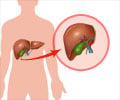Transient elastography (TE), a noninvasive, ultrasonic imaging modality, can be accurately performed in the majority of patients with nonalcoholic fatty liver disease (NAFLD)
Transient elastography (TE), a noninvasive, ultrasonic imaging modality, can be accurately performed in the majority of patients with nonalcoholic fatty liver disease (NAFLD) to exclude advanced fibrosis, researchers from France and Hong Kong have determined.
Full findings of this study, funded by the Chinese University of Hong Kong, appear in the February issue of Hepatology, a journal published by Wiley-Blackwell on behalf of the American Association for the Study of Liver Diseases.NAFLD is the most common cause of liver disease worldwide. Determining a prognosis for this condition is difficult, as there are no clear predictors of whether NAFLD will progress to nonalcoholic steatohepatitis (NASH), which can lead to cirrhosis and other complications.
Liver biopsy is the standard for diagnosing NASH and fibrosis, but this procedure can be risky and samples only a small percentage of liver tissue. According to the National Institute of Diabetes and Digestive and Kidney Diseases (NIDDK), part of the National Institutes of Health (NIH), biopsy carries a small risk of hemorrhage, puncture of other internal organs, infection, and spread of cancer cells. Transvenous liver biopsy carries an additional risk of adverse reaction to the contrast material.
To meet the urgent need for noninvasive alternatives to liver biopsy, a research team led by Victor de Lédinghen, M.D., Ph.D., conducted an evaluation of the accuracy of TE and biochemical tests for the diagnosis of fibrosis and cirrhosis in NAFLD patients. "Transient elastography by Fibroscan is a non-invasive method for the diagnosis of liver fibrosis…Nevertheless, NAFLD patients are underrepresented in previous validation studies," explains Dr. de Lédinghen. The team also examined liver stiffness in association with hepatic steatosis, inflammation, and obesity, and set out to identify factors associated with discordance between liver stiffness measurements (LSM) and histology.
The research team evaluated 246 patients from two ethnic groups from two hospitals in France and Hong Kong with valid LSM acquisitions and satisfactory liver biopsy specimens. Men who consumed more than 30 g of alcohol per week and women who consumed more than 20 g of alcohol per week were excluded. Patients with secondary causes of hepatic steatosis (e.g. chronic use of systemic corticosteroids), positive hepatitis B surface antigen or anti-hepatitis C virus antibody, or histologic evidence of other concomitant chronic liver diseases were also excluded. Since the aim of transient elastography was to diagnose significant fibrosis and early cirrhosis, patients with clinical and radiological evidence of cirrhosis were excluded.
Researchers found that successful measurement could be obtained in over 97% of patients with BMI below 30 kg/m2 and 75% of obese patients. LSM was not affected by hepatic steatosis, necroinflammation and obesity. Most discordance between TE and histology occurred in patients with short liver biopsy lengths and mild or no fibrosis. In addition, TE had superior performance to other non-invasive biochemical tests in diagnosing advanced fibrosis and cirrhosis.
Advertisement
Dr. de Lédinghen also cautions that while TE has a high negative predictive value, the positive predictive value of TE and other noninvasive tests to diagnose advanced fibrosis in NAFLD patients remains modest. He states, "The main value of these tests is to exclude advanced fibrosis as screening tests. Based on our data, it is reasonable to consider liver biopsy in patients whose LSM is 7.9 kPa or above."
Advertisement
Source-Eurekalert
RAS









